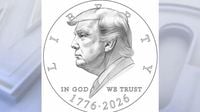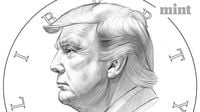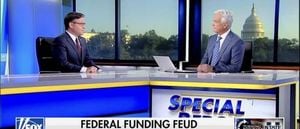The U.S. Treasury has ignited a firestorm of debate and curiosity by unveiling a draft design for a commemorative one-dollar coin featuring President Donald Trump—a move that, if realized, could mark only the second time in American history that a sitting president’s likeness appears on official U.S. currency. The draft, revealed on October 3, 2025, by U.S. Treasurer Brandon Beach via his X (formerly Twitter) account, is intended to celebrate the 250th anniversary of American independence in 2026, but it faces a thicket of legal and political obstacles that could keep it from ever reaching Americans’ pockets.
The proposed coin, as seen in images circulated online and confirmed authentic by Beach, is nothing if not bold. The obverse side features President Trump’s profile, flanked by the words “LIBERTY” and “IN GOD WE TRUST,” along with the years “1776·2026”—a nod to both the nation’s founding and the planned year of issuance. On the reverse, the coin depicts a moment etched into recent national memory: Trump, fist raised, in the aftermath of the July 2024 assassination attempt during a campaign rally in Pennsylvania. Behind him, the American flag waves, and above his head, the phrase “FIGHT, FIGHT, FIGHT” is emblazoned—a direct reference to the words he shouted after surviving the attack (Reuters via U.S. Treasury Department).
Beach, in his social media post, was unequivocal about the authenticity of the design: “No fake news here. These first drafts honoring America’s 250th Birthday and @POTUS are real,” he wrote, signaling both pride and a readiness for the controversy that would follow. Conservative activist Steve Guest amplified the sentiment, posting, “ATTENTION ALL PATRIOTS: America is back, and so is the one-dollar coin. @POTUS @realDonaldTrump will forever be the face of America’s 250th Birthday, thanks to @SecScottBessent and @TreasurerBeach. These first drafts show that our nation is ready to FIGHT, FIGHT, FIGHT!!!” Beach reshared the post, further fueling public interest.
Yet, for all the fanfare, the path from draft to minted coin is far from clear. The legal landscape is fraught with prohibitions and traditions that have long kept living presidents off of U.S. money. As Axios and CNN have reported, a 2020 law authorizing a one-year run of commemorative one-dollar coins for the nation’s semiquincentennial provides the statutory basis for the coin, but it also contains explicit restrictions: “No coin issued under this subsection may bear the image of a living former or current President.” The law further precludes images of deceased presidents within two years of their passing (Axios; U.S. Code § 5112).
The rationale for this rule, as detailed by The New York Times and echoed in numismatic circles, dates back to 1866. After a Treasury official managed to sneak his own face onto fractional currency, a backlash ensued, cementing a tradition meant to avoid any whiff of monarchy or self-aggrandizement. Since then, only one sitting president—Calvin Coolidge in 1926—has appeared on a U.S. coin, and even that was a rare exception, as the U.S. Mint notes. Coolidge’s half-dollar, issued alongside George Washington, remains the lone precedent for what the Trump coin proposes.
Legal scholars and Treasury officials have acknowledged the hurdles. As POLITICO and CNN report, some have speculated whether the Treasury might try to sidestep the ban by using a non-traditional depiction—perhaps a symbolic image rather than a classic bust portrait. But most experts agree that such maneuvering would likely end up in court, given the clarity of the statute and the strong public sentiment around the issue. “The final design has not yet been confirmed, but this draft symbolizes America’s democracy and founding spirit in the face of adversity,” a Treasury Department spokesperson told CNN, hinting at both the coin’s intended message and the uncertainty clouding its future.
Adding to the complications, the process has been slowed by a partial government shutdown that has hampered routine communications within the Treasury Department. Beach himself referenced the political gridlock in his posts, writing, “Looking forward to sharing more soon, once the obstructionist shutdown of the United States government is over.” As of early October 2025, there is no announced timetable for a final decision or design selection (NewsNation; Axios).
The debate over the proposed Trump coin is about more than just metal and minting. For supporters, the coin is a celebration of American resilience and a tribute to a president who, in their view, embodies the country’s fighting spirit—especially after surviving an assassination attempt. “This first draft reflects well the enduring spirit of our country and democracy, even in the face of immense obstacles,” a Treasury spokesperson stated, as reported by Axios and POLITICO.
On the other hand, critics—both legal and political—see the move as a violation of long-standing norms and a potential politicization of the nation’s currency. The explicit legal ban, they argue, exists for good reason: to prevent the kind of personality cults and political manipulation more commonly seen in less stable democracies. The specter of a court battle looms large, with experts predicting that any attempt to issue the coin as currently drafted would almost certainly be challenged.
The coin’s design itself is laden with symbolism. The phrase “FIGHT, FIGHT, FIGHT” and the imagery of Trump’s raised fist are unmistakable references to the dramatic events of July 2024, when Trump survived an assassination attempt during a campaign rally in Pennsylvania. That moment, captured on the coin’s reverse, has become an emblem for his supporters—a rallying cry for perseverance and defiance. For others, though, it is a stark reminder of the divisive and turbulent times that have marked recent American political life (Reuters; The Asia Business Daily).
Numismatists and coin collectors are watching the situation closely. Commemorative coin programs are often the subject of intense scrutiny, given the strict “fence line” Congress has built around what can and cannot be depicted. If the administration presses ahead, observers will be keen to see whether the final design attempts to “thread the needle” by avoiding a traditional portrait or by framing the image as symbolic rather than literal. “Expect intense scrutiny from numismatists and lawyers, since commemorative coin programs can proceed only within the fence line Congress built,” noted one analysis (Article 2).
For now, the fate of the Trump dollar coin hangs in the balance. The Treasury has confirmed the authenticity of the drafts and the intent to commemorate America’s 250th Independence Day in 2026, but has also acknowledged the legal and procedural barriers that could derail the effort. As the nation approaches its semiquincentennial, the controversy over who—and what—belongs on its currency is a reminder that even in celebration, questions of law, tradition, and identity are never far from the surface.
Whatever the outcome, the debate itself speaks volumes about the American experiment: a nation perpetually wrestling with its past, its principles, and the meaning of its most enduring symbols.





